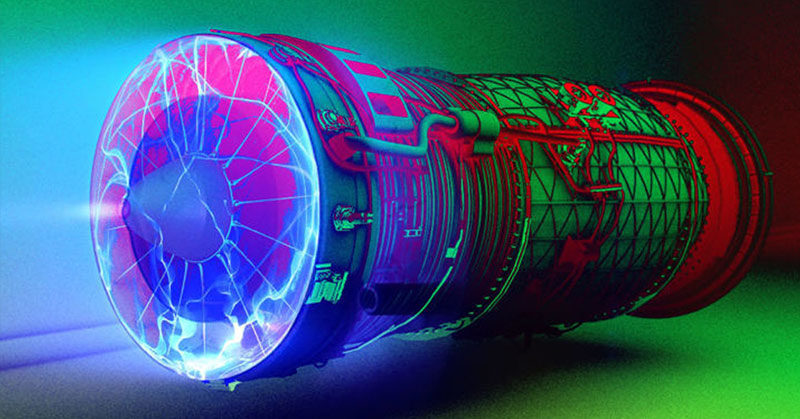In May 2020 civil unrest and murder hornets all but eclipsed any other newsworthy events at the time. For this reason, when a scientist in China invented a new jet engine that could change the future of jet propulsion, it went largely unnoticed.
Jua Tang’s jet engine that turns electricity directly into thrust, however, could eliminate the need for fossil fuels and revolutionize air and possibly even space travel.
A New Jet Engine
As a society, we depend on fossil fuels as our primary source of energy. This is particularly true when it comes to transportation. The burning of fossil fuels, however, is the single largest source of greenhouse gas emissions [1].
For this reason, scientists have been working to find replacements for fossil fuels that are more sustainable.
Jua Tang, a professor at Wuhan University, has created a jet engine prototype that turns electricity directly into thrust. He believes that his invention has the potential to be scaled-up enough to fly large commercial planes. Eventually, he says, it may even be able to power spaceships.
“The motivation of our work is to help solve the global warming problems owing to humans’ use of fossil fuel combustion engines to power machinery, such as cars and airplanes,” said Tang [2].
How Does this Jet Engine Work?
This new jet engine uses plasma. Plasma is the fourth state of matter, after solid liquid, and gas. It already exists on the surface of the sun and in lightning, but humans can also create it. The researchers created this plasma jet by compressing air into high pressures. They then used a microwave to ionize the pressurized air stream.
Others have attempted to make plasma jet thrusters, but they have been unsuccessful. For example, NASA used xenon plasma for its space probe, Dawn. It could not, however, overcome the friction in the Earth’s atmosphere. This meant that it was not powerful enough to use for air transportation.
Tang’s prototype is different because it only uses injected air and electricity to generate high-temperature, high-pressure plasma.
The jet engine prototype can lift a one-kilogram steel ball over a 24-millimeter diameter quartz tube. There, the high-pressure air passes through a microwave ionization chamber, which converts it into a plasma jet [2].
Read: New Flying-V Plane Prototype Takes To Skies For The Very First Time
Are Jet Engines the Way of the Future?
Tang and his fellow researchers believe that their device could be scaled up to a full-size jet. If they achieve this, it could drastically reduce our dependence on fossil fuels, or eliminate it altogether.
“We demonstrated that, given the same power consumption, [the plasma jet engine’s] propulsion pressure is comparable to that of conventional airplane jet engines using fossil fuels,” said the researchers. “Therefore, such a carbon-emission free thruster could potentially be used as a jet thruster in the atmosphere.” [3]
As of today, however, we are still far away from seeing this technology in a commercial setting. It is still in its prototype phase, afterall. With technology like this, problems often arise when scientists attempt to build a vehicle that actually works.
As of now, the prototype was able to lift a one-kilogram steel ball into the air with only about four hundred watts of microwave power. The scientists estimated that it reached a jet pressure of 2400 newtons per square meter. This is comparable to the jet pressure of a commercial aircraft engine.
Current limitations, however, mean that it will likely be another ten years before the technology becomes useful on a larger scale.
“For an air-plasma engine to power a large jumbo jet, it would require a large array of megawatt microwave sources, high-power turbine compressors, and an extremely high electric energy storage capability. I guess that development could take another decade,” explained Tang [4].
Working Out the Kinks
He does believe, however, that within the next five years they may be able to scale-up the prototype to power small, pilotless airplanes or heavy-duty drones to carry cargo for shipping.
If they are able to create a jet engine powerful enough to drive an airplane, they will have to tackle another problem: weight. The batteries they would need would be so heavy that it wouldn’t leave any carrying capacity for anything else.
Tang says that they will worry about the size and weight of the engine once they have managed to scale-up the device. He admits that he and his team also need to do further research on how to deal with the impact of high temperature on equipment, and how to deal with driving force [3].
All this means that this new jet engine may not be putting airplanes in the sky just yet. It is, however, the most promising research to date in this category. Scientists around the world are watching Tang and his team to see how their prototype continues to develop.
“Our results demonstrated that such a jet engine based on microwave air plasma can be a potentially viable alternative to the conventional fossil fuel jet engine,” Tang said [3].
Keep Reading: New coral reef taller than Eiffel Tower found off Australian coast
- https://www.epa.gov/ghgemissions/sources-greenhouse-gas-emissions#:~:text=The%20largest%20source%20of%20greenhouse,electricity%2C%20heat%2C%20and%20transportation.
- https://www.sciencedaily.com/releases/2020/05/200505121705.htm
- https://aip.scitation.org/doi/10.1063/5.0005814
- https://spectrum.ieee.org/energywise/aerospace/aviation/plasma-jet

